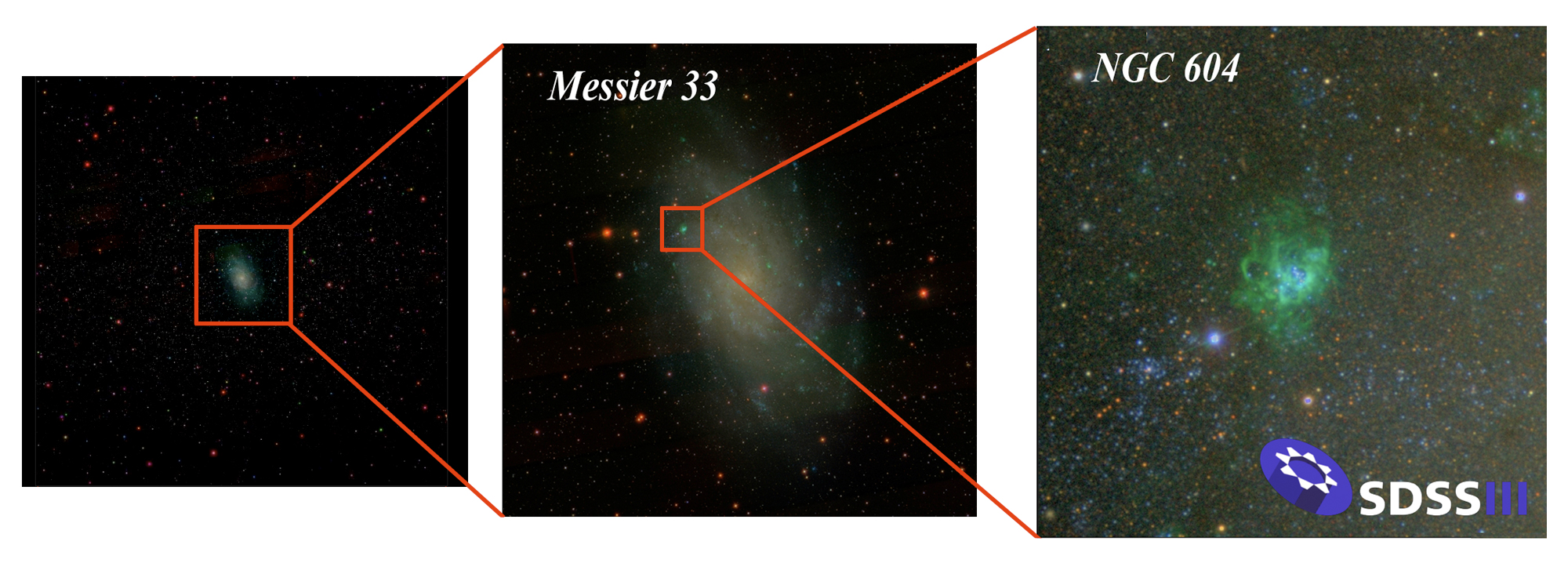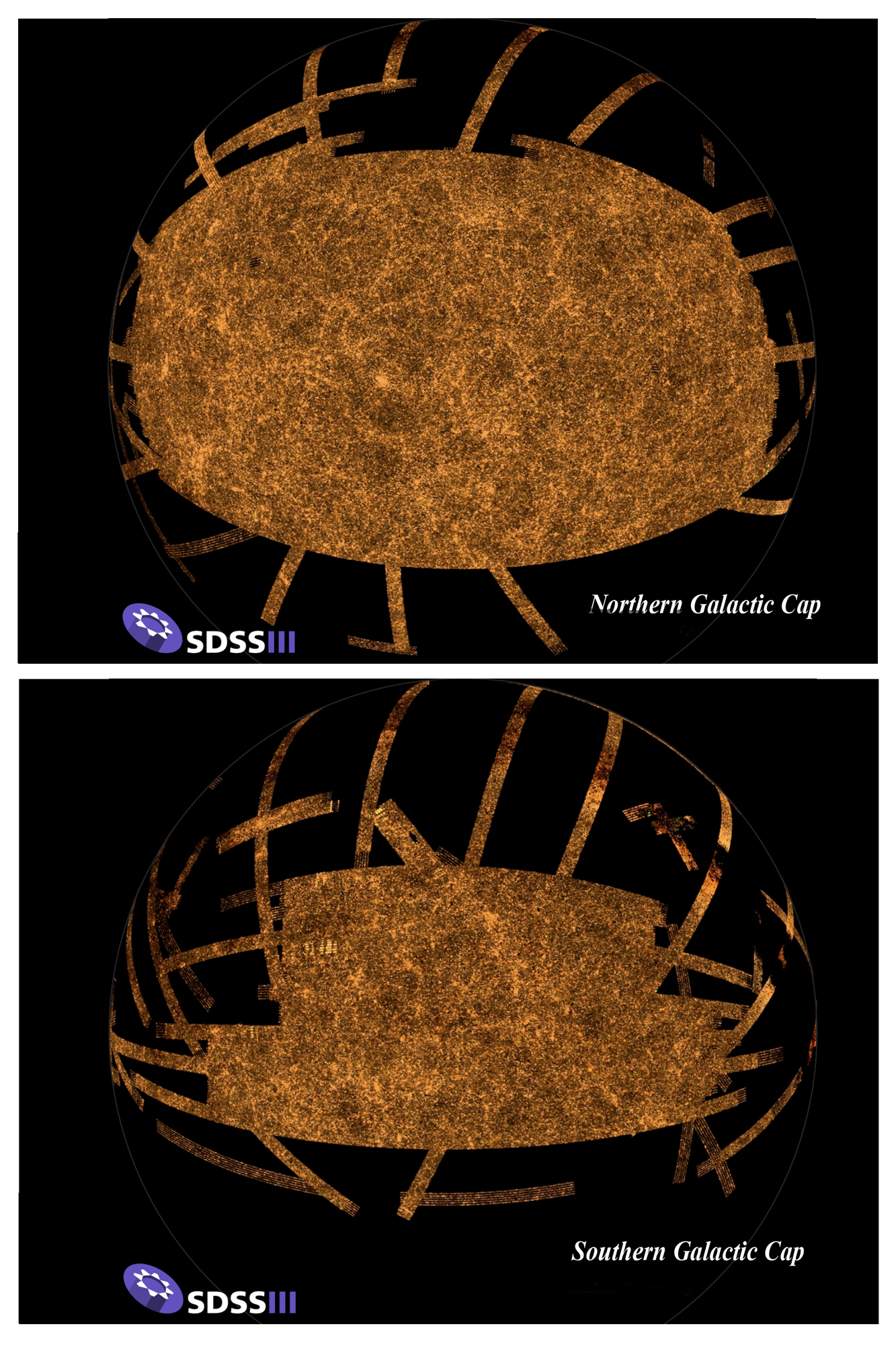On Tuesday, January 11, at the 217th meeting of the American Astronomical Society in Seattle, WA, astronomers and physicists with the third Sloan Digital Sky Survey (SDSS-III) announced the release of the largest color image of the sky yet made. In the following press release issued by the SDSS-III collaboration, cosmologist David Schlegel of Berkeley Lab’s Physics Division, principal investigator of SDSS-III’s Baryon Oscillation Spectroscopic Survey (BOSS), discusses future maps of the sky and the role the giant image has played in targeting over a million galaxies for BOSS’s study of dark energy and the history of the expansion of the universe.

SDSS-III's new image contains a wealth of information on scales both small and large. At left is the SDSS-III view of a small part of the sky, centered on the galaxy Messier 33 (M33). A zoom-in on M33 at center shows the spiral arms of this galaxy, including the blue knots of intense star formation known as H II regions. At right, a further zoom into M33 shows the object NGC 604, one of the largest H II regions in that galaxy. (From M. Blanton and SDSS-III. Click on image for better resolution.)
__________________________________________________________
Scientific contacts: Michael Blanton, New York University, 646-279-5098
Connie Rockosi, University of California Santa Cruz, 831-459-5246
David Schlegel, Lawrence Berkeley National Laboratory, 510-495-2595
Bob Nichol, University of Portsmouth, SDSS-III Scientific Spokesperson, +44 7963 792049
Jordan Raddick, SDSS-III Public Information Officer, 443-570-7105
__________________________________________________________
Seattle, WA – On Tuesday, Jan. 11, the Sloan Digital Sky Survey-III (SDSS-III) released the largest digital color image of the sky ever made, and it’s free to all. The image has been put together over the last decade from millions of 2.8-megapixel images, thus creating a color image of more than a trillion pixels. This terapixel image is so big and detailed that one would need 500,000 high-definition TVs to view it at its full resolution.
“This image provides opportunities for many new scientific discoveries in the years to come,” exclaims Bob Nichol, a professor at the University of Portsmouth and Scientific Spokesperson for the SDSS-III collaboration.
The new image is at the heart of new data being released by the SDSS-III collaboration at the 217th American Astronomical Society meeting in Seattle. This new SDSS-III data release, along with the previous data releases that it builds upon, gives astronomers the most comprehensive view of the night sky ever made. SDSS data have already been used to discover nearly half a billion astronomical objects, including asteroids, stars, galaxies, and distant quasars. The latest, most precise positions, colors, and shapes for all these objects are also being released today.
“This is one of the biggest giveaways in the history of science,” says Professor Mike Blanton from New York University, who is leading the data archive work in SDSS-III. Blanton and many other scientists have been working for months preparing the release of all this data. This data will be a legacy for the ages, explains Blanton, as previous ambitious sky surveys, like the Palomar Sky Survey of the 1950s, are still being used as references even today. “We expect the SDSS data to have that sort of shelf life,” comments Blanton.
The image was started in 1998 using what was then the world’s largest digital camera – a 138-megapixel imaging detector on the back of a dedicated 2.5-meter telescope at the Apache Point Observatory in New Mexico. Over the last decade, the Sloan Digital Sky Survey has scanned a third of the whole sky. Now, this imaging camera is being retired, and will be part of the permanent collection at the Smithsonian in recognition of its contributions to Astronomy.
“It’s been wonderful to see the science results that have come from this camera,” says Connie Rockosi, an astronomer from the University of California at Santa Cruz, who started working on the camera in the 1990s as an undergraduate student with Jim Gunn, Professor of Astronomy at Princeton University and SDSS-I/II Project Scientist. Rockosi’s entire career so far has paralleled the history of the SDSS camera. “It’s a bittersweet feeling to see this camera retired, because I’ve been working with it for nearly 20 years,” she says.
But what next? This enormous image has formed the basis for new surveys of the universe using the SDSS telescope. These surveys rely on spectra, an astronomical technique that uses instruments to spread the light from a star or galaxy into its component wavelengths. Spectra can be used to find the distances to distant galaxies, and the properties (such as temperature and chemical composition) of different types of stars and galaxies.
“We have upgraded the existing SDSS instruments, and we are using them to measure distances to over a million galaxies detected in this image,” explains David Schlegel, an astronomer from the U.S. Department of Energy’s Lawrence Berkeley National Laboratory and the principal investigator of the new SDSS-III Baryon Oscillation Spectroscopic Survey (BOSS). Schlegel explains that measuring distances to galaxies is more time-consuming than simply taking their pictures, but in return it provides a detailed three-dimensional map of the galaxies’ distribution in space.
BOSS started taking data in 2009 and will continue until 2014, explains Schlegel. Once finished, BOSS will be the largest 3-D map of galaxies ever made, extending the original SDSS galaxy survey to a much larger volume of the universe. The goal of BOSS is to precisely measure how so-called dark energy has changed over the recent history of the universe. These measurements will help astronomers understand the nature of this mysterious substance. “Dark energy is the biggest conundrum facing science today,” says Schlegel, “and the SDSS continues to lead the way in trying to figure out what the heck it is!”

A map of the whole sky, derived from the SDSS-III image, is divided into the northern and southern hemispheres of our Milky Way galaxy. Visible in the map are the clusters and walls of galaxies that are the largest structures in the entire universe. (From M. Blanton and SDSS-III. Click on image for better resolution.)
In addition to BOSS, the SDSS-III collaboration has been studying the properties and motions of hundreds of thousands of stars in the outer parts of our Milky Way galaxy. The survey, known as the Sloan Extension for Galactic Understanding and Exploration – or SEGUE – started several years ago but has now been completed as part of the first year of SDSS-III.
In conjunction with the image being released today, astronomers from SEGUE are also releasing the largest map of the outer Galaxy ever released. “This map has been used to study the distribution of stars in our galaxy,” says Rockosi, the principal investigator of SEGUE. “We have found many streams of stars that originally belonged to other galaxies torn apart by the gravity of our Milky Way. We’ve long thought that galaxies evolve by merging with others; the SEGUE observations confirm this basic picture.”
SDSS-III is also undertaking two other surveys of our galaxy through 2014. The first, called MARVELS, will use a new instrument to repeatedly measure spectra for approximately 8,500 nearby stars like our own sun, looking for the tell-tale wobble caused by large Jupiter-like planets orbiting them. MARVELS is predicted to discover around a hundred new giant planets, as well as potentially finding a similar number of brown dwarfs, which are intermediate between the most massive planets and the smallest stars.
The second survey is the APO Galactic Evolution Experiment (APOGEE), which is using one of the largest infrared spectrographs ever built to undertake the first systematic study of stars in all parts of our galaxy, even stars on the other side of our galaxy beyond the central bulge. Such stars are traditionally difficult to study as their visible light is obscured by large amounts of dust in the disk of our galaxy. However, by working at longer, infrared wavelengths, APOGEE can study them in great detail, thus revealing their properties and motions to explore how the different components of our galaxy were put together.
“The SDSS-III is an amazingly diverse project built on the legacy of the original SDSS and SDSS-II surveys,” summarizes Nichol. “This image is the culmination of decades of work by hundreds of people, and has already produced many incredible discoveries. Astronomy has a rich tradition of making all such data freely available to the public, and we hope everyone will enjoy it as much as we have.”
Additional information
SDSS-III announced Data Release Eight (DR8) on Jan. 11, 2011, at the 217th meeting of the American Astronomical Society. The release can be found at http://www.sdss3.org/dr8. All data published as part of DR8 is freely available to other astronomers, scientists, and the public. Technical journal papers describing DR8 and the SDSS-III project were also released on this date on the arXiv e-Print archive.
A composite image including the zoom in to NGC 604 and the northern and southern galactic maps is available at http://tinyurl.com/2amuwcj. Larger images of the maps in the northern and southern galactic hemispheres are available at http://tinyurl.com/27tntqb and http://tinyurl.com/25z4h3e.
The SDSS-III Collaboration (http://www.sdss3.org) includes many institutions from around the globe. Funding for SDSS-III has been provided by the Alfred P. Sloan Foundation, the Participating Institutions, the National Science Foundation, and the U.S. Department of Energy’s Office of Science. The SDSS-III is managed by the Astrophysical Research Consortium for the Participating Institutions of the SDSS-III Collaboration including the University of Arizona, the Brazilian Participation Group, Brookhaven National Laboratory, University of Cambridge, University of Florida, the French Participation Group, the German Participation Group, the Instituto de Astrofísica de Canarias, the Michigan State/Notre Dame/JINA Participation Group, Johns Hopkins University, Lawrence Berkeley National Laboratory, Max Planck Institute for Astrophysics, New Mexico State University, New York University, the Ohio State University, the Penn State University, University of Portsmouth, Princeton University, the Spanish Participation Group, University of Tokyo, the University of Utah, Vanderbilt University, University of Virginia, University of Washington, and Yale University.